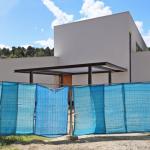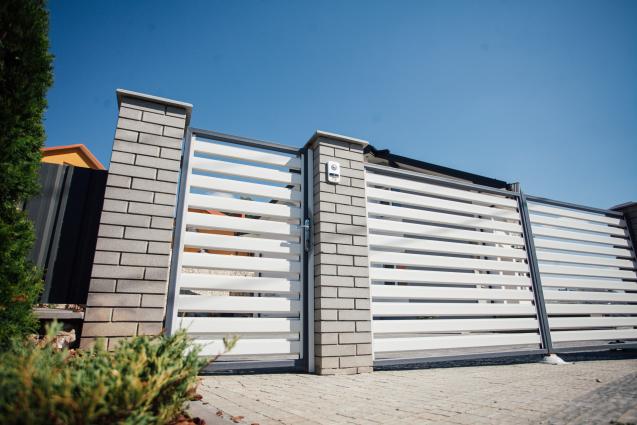
The Ultimate Guide to Temporary Fencing
Temporary fencing can be used to barricade an area for all industries and applications. It is an alternative to a permanent fence as it can be used on sites that do not regularly need fencing but need to be secured for an interim amount of construction time. Temporary fencing is used for the safety of site workers and pedestrians, theft prevention and is also a legislative requirement.
The 3 most common types of temporary fencing are:
1. Chain Link
Chain link fencing is interlocking wire fencing. It comes in a large roll of chain link and is attached to posts. The posts are put in cement holders or driven into the ground. Because the posts are secured, there is a degree of permanency to the fencing. It is considered more secure than other types of temporary fencing because it cannot be moved.
The problem with chain link, though, is the setup which can take a long time. It also is not as easy to install as fencing panels. On a construction site every minute counts, and when fencing the perimeter of a worksite, this can eat up a lot of time and can affect the entire project.
2. Mesh Link
Wire mesh fencing is the most secure type of temporary fencing, it comes in separate panels that can be used to create a secure fence around your site. The mesh is tighter and stronger than chain link, and the weight is much lighter than the chain link panels. It is very durable and easy to set up, tear down and store.
The one factor that makes mesh fencing the best choice for a construction site is its ease in handling. The panels are lightweight and can easily be handled by just one worker, making setup very cost-effective thus resulting in less downtime for your construction job.
3. Barricades
Barricades are used to create a barrier in order to prevent pedestrians or vehicles from entering your construction site. They do not offer the same level of protection that fencing does. Barricades are not as tall, and they are not built for security. Barricades are steel panels that are free standing, and they usually have several bars as opposed to wire mesh. They are easy to set up, take down and move about, but they are not the most secure type of fencing and they are not recommended for an active construction site. They simply do not offer the level of protection that is required.
The 3 most common materials used to make temporary fencing:
1. Steel Temporary Fencing
Stainless steel is a stronger, more secure metal and is less likely to be damaged. Steel fencing is ideal where strength and impact resistance is important as they are used mostly by those in the construction and resources industry, steel fencing ensures that a sturdy safety barricade between the public and the sites are made.
2. Aluminium Temporary Fencing
Aluminium is an inexpensive alternative to materials like steel or iron and is also lightweight and naturally resistant to corrosion and rust caused by the elements.
One of the reasons that aluminium is less expensive than other materials, unlike steel, is that it is a lightweight material. While aluminium can stand up to corrosion from wind, rain, temperature changes, and salty air, it is easier to bend and reform than tougher metals such as steel.
While this keeps the cost of production low, it also means aluminium is less able to withstand a concerted effort to damage or breakthrough.
3. Wood Temporary Fencing
Sometimes called wooden hoardings, hoardings are wooden fences around a construction site. Timber hoarding can be installed in concrete to provide greater rigidity and a permanent-like structure with which to protect a building or construction site.
The panels are installed using bracing techniques and can withstand a great deal of pressure; making them one of the most popular fencing options where security is vital.
The 3 most common types of temporary fencing are:
1. Chain Link
Chain link fencing is interlocking wire fencing. It comes in a large roll of chain link and is attached to posts. The posts are put in cement holders or driven into the ground. Because the posts are secured, there is a degree of permanency to the fencing. It is considered more secure than other types of temporary fencing because it cannot be moved.
The problem with chain link, though, is the setup which can take a long time. It also is not as easy to install as fencing panels. On a construction site every minute counts, and when fencing the perimeter of a worksite, this can eat up a lot of time and can affect the entire project.
2. Mesh Link
Wire mesh fencing is the most secure type of temporary fencing, it comes in separate panels that can be used to create a secure fence around your site. The mesh is tighter and stronger than chain link, and the weight is much lighter than the chain link panels. It is very durable and easy to set up, tear down and store.
The one factor that makes mesh fencing the best choice for a construction site is its ease in handling. The panels are lightweight and can easily be handled by just one worker, making setup very cost-effective thus resulting in less downtime for your construction job.
3. Barricades
Barricades are used to create a barrier in order to prevent pedestrians or vehicles from entering your construction site. They do not offer the same level of protection that fencing does. Barricades are not as tall, and they are not built for security. Barricades are steel panels that are free standing, and they usually have several bars as opposed to wire mesh. They are easy to set up, take down and move about, but they are not the most secure type of fencing and they are not recommended for an active construction site. They simply do not offer the level of protection that is required.
The 3 most common materials used to make temporary fencing:
1. Steel Temporary Fencing
Stainless steel is a stronger, more secure metal and is less likely to be damaged. Steel fencing is ideal where strength and impact resistance is important as they are used mostly by those in the construction and resources industry, steel fencing ensures that a sturdy safety barricade between the public and the sites are made.
2. Aluminium Temporary Fencing
Aluminium is an inexpensive alternative to materials like steel or iron and is also lightweight and naturally resistant to corrosion and rust caused by the elements.
One of the reasons that aluminium is less expensive than other materials, unlike steel, is that it is a lightweight material. While aluminium can stand up to corrosion from wind, rain, temperature changes, and salty air, it is easier to bend and reform than tougher metals such as steel.
While this keeps the cost of production low, it also means aluminium is less able to withstand a concerted effort to damage or breakthrough.
3. Wood Temporary Fencing
Sometimes called wooden hoardings, hoardings are wooden fences around a construction site. Timber hoarding can be installed in concrete to provide greater rigidity and a permanent-like structure with which to protect a building or construction site.
The panels are installed using bracing techniques and can withstand a great deal of pressure; making them one of the most popular fencing options where security is vital.



